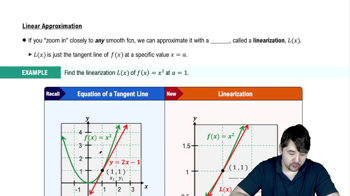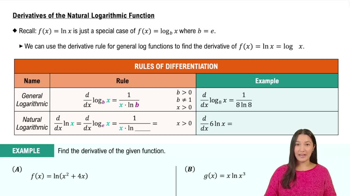Table of contents
- 0. Functions7h 52m
- Introduction to Functions16m
- Piecewise Functions10m
- Properties of Functions9m
- Common Functions1h 8m
- Transformations5m
- Combining Functions27m
- Exponent rules32m
- Exponential Functions28m
- Logarithmic Functions24m
- Properties of Logarithms34m
- Exponential & Logarithmic Equations35m
- Introduction to Trigonometric Functions38m
- Graphs of Trigonometric Functions44m
- Trigonometric Identities47m
- Inverse Trigonometric Functions48m
- 1. Limits and Continuity2h 2m
- 2. Intro to Derivatives1h 33m
- 3. Techniques of Differentiation3h 18m
- 4. Applications of Derivatives2h 38m
- 5. Graphical Applications of Derivatives6h 2m
- 6. Derivatives of Inverse, Exponential, & Logarithmic Functions2h 37m
- 7. Antiderivatives & Indefinite Integrals1h 26m
- 8. Definite Integrals4h 44m
- 9. Graphical Applications of Integrals2h 27m
- 10. Physics Applications of Integrals 2h 22m
4. Applications of Derivatives
Linearization
Problem 41
Textbook Question
Use linear approximations to estimate the following quantities. Choose a value of a to produce a small error.
ln 1.05
 Verified step by step guidance
Verified step by step guidance1
Identify the function you want to approximate. In this case, it's the natural logarithm function, \( f(x) = \ln(x) \).
Choose a value of \( a \) close to 1.05 where the function is easy to compute. A good choice is \( a = 1 \) because \( \ln(1) = 0 \).
Find the derivative of the function, \( f'(x) = \frac{1}{x} \). This will be used to find the slope of the tangent line at \( x = a \).
Calculate the slope of the tangent line at \( x = a \) using the derivative: \( f'(a) = \frac{1}{1} = 1 \).
Use the linear approximation formula \( L(x) = f(a) + f'(a)(x - a) \) to estimate \( \ln(1.05) \). Substitute \( a = 1 \), \( f(a) = 0 \), and \( f'(a) = 1 \) into the formula to get \( L(x) = 0 + 1 \cdot (x - 1) = x - 1 \). Evaluate \( L(1.05) = 1.05 - 1 \).
 Verified video answer for a similar problem:
Verified video answer for a similar problem:This video solution was recommended by our tutors as helpful for the problem above
Video duration:
2mPlay a video:
Was this helpful?
Key Concepts
Here are the essential concepts you must grasp in order to answer the question correctly.
Linear Approximation
Linear approximation is a method used to estimate the value of a function near a given point using the tangent line at that point. It is based on the idea that a function can be closely approximated by a linear function when the input is near a specific value. The formula for linear approximation is f(x) ≈ f(a) + f'(a)(x - a), where 'a' is the point of tangency.
Recommended video:

Linearization
Derivative
The derivative of a function at a point measures the rate at which the function's value changes as its input changes. It is a fundamental concept in calculus that provides the slope of the tangent line to the function at that point. For the natural logarithm function, the derivative is given by f'(x) = 1/x, which is essential for calculating the linear approximation.
Recommended video:

Derivatives
Natural Logarithm
The natural logarithm, denoted as ln(x), is the logarithm to the base 'e', where 'e' is approximately 2.71828. It is a key function in calculus and is used to solve problems involving exponential growth and decay. Understanding the properties of the natural logarithm, such as its behavior near 1, is crucial for effectively using linear approximations to estimate values like ln(1.05).
Recommended video:

Derivative of the Natural Logarithmic Function
Related Videos
Related Practice



